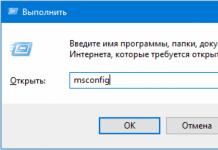If you have a laptop, netbook, or transformer in front of you, then the keyboard on it is probably somewhat different from the one we are used to seeing next to a desktop PC. It is more compact, so some of the buttons on it perform two functions. The Fn key helps them switch from the main to the secondary task and vice versa. Let's find out the breadth of its capabilities and options for eliminating problems associated with it.
Where is Fn?
The button location is standard for all laptop keyboards and their counterparts made by HP, Lenovo, Samsung, LG, Acer, ASUS, etc. This is traditionally the left corner. The only difference is whether the Fn key on the keyboard will appear before Ctrl or after it.
The location of the button is specially chosen to be so convenient, because it is the “key” to many necessary functions. It is always at hand, you don’t need to look for it, the location is easy to remember, including when using “touch typing”.
What is the button for?
The full name of the Fn key is Function. It is combinational - it works only in combination with other buttons. Take a closer look at your keyboard. Row F1-F12, arrows "up-down", "right-left" will contain additional icons symbolizing specific functions. They are printed with ink usually red or blue - the same color as the Fn key. By pressing it and a specific button at the same time, you can activate/deactivate a specific function.

Thus, the key helps to control the player, flip through photos, pages, increase/decrease the sound volume, increase/decrease the screen brightness and perform a number of other useful tasks.
Useful button combinations
The symbols depicted on the Function keys are quite intuitive and quickly remembered. You will soon get used to them and will switch them without looking. Now we will provide a list of standard functions that the Fn key helps to activate:
- With the "up" arrow - increase the sound volume.
- With the down arrow - decrease the sound volume.
- With the left arrow - decrease the brightness of the monitor.
- With the arrow to the right - increases the brightness of the monitor.
- With F8 - mute sound.
- With F7 - activation/deactivation of the touch control panel.
- With F6 - turn on/off the monitor.
- With F5 - transfer the image to an external monitor and back to the “native” one.
- With F4 - activation/deactivation of "sleep mode".
- With F3 - connect to and disconnect from Wi-Fi.
- From Home - start playback, pause.
- With Pg Up (“Page up”) - stop playback in the player.
- With Pg Dn ("Page Down") - rewind.
- With End (“Towards the end”) - fast forward.
The last four functions on some keyboards can be moved to the F9, F10, F11, F12 buttons. You need to hold down the Fn key and then click on one of the presented ones to enable or disable what you need.
Enable or disable a button
The Function itself can be activated or deactivated. This is done as follows: hold down the button itself and Num Lock. The combination will help both disable the Fn key and enable it. But the method is not applicable to all devices.
You can try setting it up through the BIOS:
- Turn off your computer.
- Turn it back on. In this case, it is important to hold down the F2, F10, Del button - depending on your BIOS version.
- As soon as the characteristic screen appears in front of you, use the left-right keys to scroll the cursor to System Configuration. These are the system settings.
- In this tab, use the up and down buttons to get to Action Keys Mode (function button settings). Select this item by pressing "Enter".
- You will have two options: Enabled - turn it on, and Disabled - turn it off.
- Place the cursor on the desired one and press Enter again.
- Now all that remains is to press the F10 button to exit the BIOS and make all changes.

Now let's look at some problems and options for eliminating them.
The button works the other way around
When the Fn key works in reverse, we see the following situation: if it is not pressed, for some reason the additional functions of its “colleagues” are performed, and in the opposite situation, the main ones are performed. For example, when scrolling through a page with the up arrow, the sound starts to increase. And if we hold down Function, then we move up the document sheet, as expected.
The reason is that the key mode has switched: the main one has become an additional one. You can put everything back in place like this:
- Press the Fn Lock button, which activated this “disgrace”.
- Go to the BIOS according to the diagram presented above. Find the section dedicated to the keyboard (Key, Keys). Activate the item highlighted in the photo below if it is disabled, or deactivate if it is enabled.

The button does not work correctly, does not function
It may happen that Fn performs its functions strangely. Or maybe even inactive. The problem here is that the drivers installed are inappropriate for your OS or there are none at all. Everything can be solved by removing (if any) the old hotkeys and installing the necessary new ones:
- For Lenovo - ATK Hotkey.
- For HP - hpHotkeyMonitor.
- For Sony - Hotkey Utility.
- For Acer -
- For ASUS - ATK.
- For Samsung - Easy Display Manager.
You can also use the fairly universal Magic Keyboard driver. Another option: go to the official website of your laptop manufacturer and there find and download the necessary “firewood” for Function.
The Fn key on laptops, netbooks, and ultrabooks is functional and combinational. It provides access to “hot tasks” located on dual-use buttons.
Every laptop has several function keys that allow you to quickly open various system components. The Fn button provides access to individual system settings. This key is used in combination with the F1-F12 buttons, which allows, for example, to change the sound level, turn on Wi-Fi, or activate the economy mode on a laptop. On many laptops it is located in the lower left corner of the keyboard.
Fn button does not work
There are several methods you can try to solve this problem. Let's take a closer look at each of them.
Installing drivers.
You can download the driver pack for the keyboard from the manufacturer’s official website. You need to look for components for a specific computer model. Perhaps installing “firewood” will help enable the Fn key.
Use of special programs.
You can use special applications to activate the Fn button. Magic Keyboard is considered a popular utility suitable for all laptops.
If the above methods do not help, then you can try cleaning the keyboard.
How to disable the Fn key on a laptop?
There are two main ways to disable this button. The first involves using the NumLock+Fn or Fn+F11 key combination. The second method is more complex, it includes several steps.
- Go to BIOS. To do this, during the system boot process, you need to press the F8 button or another (depending on the brand of laptop).
- Select the “System Configuration” tab.
- In the “Action Keys Mode” item, select “Disabled”.
- Save changes.
After this, the Fn button on your Lenovo laptop will be disabled. It is worth noting that this key is quite useful. It helps to quickly access different options, which means it saves the user’s time. You need to think carefully before turning it off.
It would seem that the laptop keyboard is no different from the keyboard of a regular PC. However, there is a certain difference: only this compact device has an Fn button. It exists to improve user efficiency. Fn helps to quickly turn on Bluetooth, Wi-Fi, send mail, change screen brightness, volume level, etc. If the Fn key does not work on a laptop, this significantly “cuts down” the user’s capabilities.
Enabling the Fn key opens up a lot of possibilities for the user
Location
The Fn button on almost all devices is located in the lower left corner of the keyboard. This key has long taken its permanent place on devices of various world-famous brands of equipment. It is located before or after the Ctrl button. As practice shows, this placement of the key is very convenient for users.
How it works and what “Fn” means
“Function” - it is from this word that the name of the key we are interested in comes from. With its help you can perform many operations, but in combination with other buttons. They are commonly called shortcut buttons. The key combination differs for each specific model, but the principle of their operation is the same. For example, on a Lenovo laptop, the Fn button can give the following results:
- Fn+right arrow/left arrow - change volume;
- Fn+Insert - option to disable or enable Scroll Lock;
- Fn+F6 - connect a laptop mouse (touchpad);
- Fn+F5 - turn on bluetooth;
- Fn+F4 - change the monitor extension;
- Fn+F3 - used when working with a projector; This combination makes it possible to switch the monitor display to the projector;
- Fn+F2 - option to turn off/on the monitor;
- Fn+F1 - sleep mode;
- Fn+down/up arrow - decrease or increase monitor brightness;
- Fn+F12 - track backward;
- Fn+F11 - track forward;
- Fn+F10 - stop in the media player;
- Fn+F9 - pause/resume;
- Fn+Home - (works in media files) - pause.
By learning these combinations, you will be able to get the most out of your laptop keyboard, even without using a mouse.
Disable/enable Fn
Usually the button is activated by pressing NumLock+Fn, but this does not always work. Often, to enable the Fn button on a laptop, you have to delve into the BIOS.
Using BIOS
There is nothing complicated here, the procedure looks like this:
- Go to the BIOS (you must press Esc, F2 or Del when the device starts).
- Go to Setup Utility.
- Find the System Configuration menu.
- Turn on the Fn option (Action Keys Mode tab).

Installing drivers
The most effective way to enable the Fn key is to check your keyboard drivers. When installing a “broken” OS, the wrong “firewood” is often installed for individual laptop components. Experienced specialists recommend downloading drivers only from the official pages of manufacturing companies. On official resources you can easily find Fn key drivers for HP, Sony, LG, Lenovo, Acer, DNS, Toshiba, Dell and many others.

Using Utilities
Sometimes no changes occur even after following the recommendations described here. In this case, special utilities can help. You can find a lot of programs online to enable the Fn key, many of them are available for free.
Thus, Vaio Control Center and Sony Shared Library utilities have been developed for Sony devices; Easy Display Manager is ideal for Samsung devices (usually this program is supplied on disk in the same package with the purchased equipment). On a Toshiba laptop, it is better to install Flash Cards Support Utility or Hotkey Utility.

There is also universal software that will enable the Fn button on any device - this is the Magic Keyboard utility.
Nothing helped? Clean your keyboard!
Perhaps the problem is mechanical damage to the keyboard. Liquid could have been spilled on it (most often it is coffee or tea) or dust could be the culprit. The issue will have to be resolved not by the program method, but by “treatment” from the outside. It is not necessary to take the device to a service center; you can try to fix everything yourself. Each key on the laptop is fixed in its own slot, and if you apply a little effort, you can carefully remove it (just pry it off with a screwdriver). All buttons consist of a lift, a platform and a spring, these three components are connected using a latch. After removing the problem key, clean the pad, then put everything back.

The functions of the Fn button can be easily assigned to other keys that you are not used to using. It's a little unusual, but effective.
If the keyboard has been spilled with tea, the tracks may be damaged - in this case, the equipment will have to be sent to the service department.
OS bit size
It is sometimes also impossible to eliminate a system violation by installing drivers. This happens if the device you purchased is designed for a 64-bit OS, and you installed 32. Such difficulties arise quite often; the issue can only be resolved by reinstalling Windows to the required version.
Results
As you can see, the Fn button allows you to quickly enable/disable various functions, which means making life much easier, but on some laptops it may not initially function. You can enable the key using several methods: dig around, install a special utility, clean the keyboard, perform the Fn+NumLock combination, or install OS 64x. We are confident that one of the methods presented here will help enable the coveted key. Write which method was most effective in solving your problem.
Good day!
Oh, these modern keyboards, with which manufacturers are now doing everything. And the problem with the functionality of the keys even on a new device is not uncommon...
Actually, today’s article will be about the operation and configuration of the F1÷F12 and Fn function keys on laptops. The fact is that often they either do not work at all, or do not work as they should. Moreover, many manufacturers “fence” the shape of the keys, their functions, on/off, settings as they please (no standardization).
Meanwhile, the Fn, F1, F2, F3, etc. keys are very important, they allow you to quickly increase/decrease brightness and sound, turn on/off the Wi-Fi network, touchpad and much more. In general, refusing them means depriving yourself of the necessary functionality, which is not good.
Reasons for Fn and F1÷F12 not working
I remind you, that in most cases, in order for the function keys to perform an alternative function (reduce the same brightness), you must press them simultaneously with the key Fn. For example, in order to turn Wi-Fi on/off, you need to press the combination Fn+F2 (this is just an example! Each laptop has its own combinations, look carefully at the pictures on the keys).

Pressing Fn+F2 simultaneously turns Wi-Fi on or off // as an example!
1) Is Fn turned on? Is there an alternative button on the keyboard?
Some types of keyboards have additional buttons F Lock or F Mode. They allow you to block (disable) function keys. Take a closer look - do you have them?

F Lock key (most often found on classic keyboards, not laptops)
I also note that in order to use the Fn button, on some laptops you need to press a combination of buttons Fn+Esc(see screenshot below - a small lock should be drawn on the key). By the way, instead of Fn+Esc, the combination Fn+NumLock can be used.

2) BIOS settings (Hotkey Modes and analogues)
As a reference!
If you don’t know what BIOS is and how to enter it, I recommend reading this article:
In some laptops (for example, Dell Inspiron, Lenovo ThinkPad, etc.) in the BIOS you can set the operating mode of the function keys (that is, they can act in a classic role, or without pressing Fn they can immediately perform their second function: turn down the volume , enable/disable the touchpad, etc.).
Most often, to enter the BIOS, you need to restart the laptop, and when loading, immediately press the F2 or Delete keys (the buttons may be different, depending on the device model).
These modes are called: Hotkey Mode, Action Keys Mode (and other derivatives). To change their operating mode, you need to go to the BIOS Configuration section and change the mode from Enabled to Disabled (or vice versa).

3) Lack of drivers and special software from the manufacturer
When drivers are installed automatically along with Windows, or various kits/packs are used (for example, Driver Pack Solution), the system often does not have special software from the laptop manufacturer. As a result, some keys may not work (including function keys).
Below I will look at an example of updating such drivers using ASUS as an example (if you have an excellent brand of laptop, say HP, Acer, Dell, Lenovo - all actions will be similar, only the official website address will be different).

In general, if we sum it up: You just need to update the drivers by downloading them from your laptop manufacturer’s website. Moreover, this needs to be done for the specific version of Windows that you are currently using.
If for your version of Windows There are no drivers on the laptop manufacturer's website - this is a serious reason to think about switching to another version of the OS (it is quite possible that because of this, some of the functionality, including function keys, does not work).
Addition!
Perhaps someone will find this article useful on how to install drivers on a laptop or PC (various options are considered) -
4) Problem with the keyboard itself
If you dropped or - it is quite possible that the key does not work due to a physical malfunction of the keyboard.
Pay attention to whether the key responds at least sometimes (maybe try pressing it a little harder). If there is a problem with the tracks under the key, then often pressing harder will work (for example, the tracks may oxidize after being filled, or behave this way due to wear).
What can be done:

Additions are welcome.
The keyboard of any laptop must have a key block F1-F12. Often they work without any additional settings, but sometimes users are faced with a situation where, instead of their direct purpose, they perform secondary ones - multimedia.
Enabling F1-F12 keys on a laptop
As a rule, on all laptops a number of F-keys are configured for two modes: functional and multimedia. Previously, a simple single press would perform the default action within a program, game, or operating system (for example, F1 opens the application help). Pressing F-keys along with Fn has already performed another action assigned to it by the manufacturer. It could be the volume being turned off or something else.

However, more and more often in modern devices you can find the opposite principle of operation: simply pressing F-the key triggers the action assigned by the manufacturer, and the combination (take the same example with F1) Fn+F1 opens a help window.
For users using F1-F12 for a functional purpose more often than for a secondary multimedia purpose, such a change in order is often not to your liking. It is especially inconvenient for fans of computer games that require quick reactions to actions. Fortunately, you can change the priority of work very simply - by editing one of the BIOS parameters.
Read also: How to enter BIOS on a laptop,

After changing the mode, you will be able to use it without any problems, as before. F1-F12. To use additional functions such as adjusting volume, brightness, turning on/off Wi-Fi, you will need to simultaneously press the corresponding function key together with Fn.
In this short article, you learned why function keys in games, programs and Windows might not work on your laptop, as well as how to enable them. If you have any questions, use the comment form below.


























